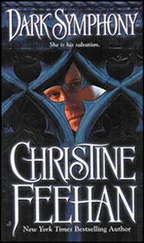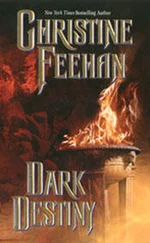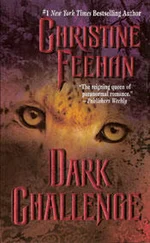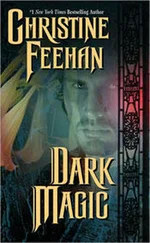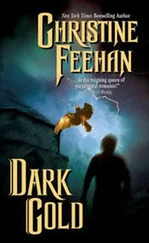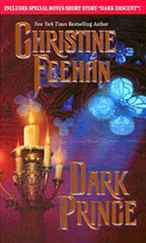Christine Feehan - Dark Celebration 17
Здесь есть возможность читать онлайн «Christine Feehan - Dark Celebration 17» весь текст электронной книги совершенно бесплатно (целиком полную версию без сокращений). В некоторых случаях можно слушать аудио, скачать через торрент в формате fb2 и присутствует краткое содержание. Жанр: Книги. Описание произведения, (предисловие) а так же отзывы посетителей доступны на портале библиотеки ЛибКат.
- Название:Dark Celebration 17
- Автор:
- Жанр:
- Год:неизвестен
- ISBN:нет данных
- Рейтинг книги:4 / 5. Голосов: 1
-
Избранное:Добавить в избранное
- Отзывы:
-
Ваша оценка:
- 80
- 1
- 2
- 3
- 4
- 5
Dark Celebration 17: краткое содержание, описание и аннотация
Предлагаем к чтению аннотацию, описание, краткое содержание или предисловие (зависит от того, что написал сам автор книги «Dark Celebration 17»). Если вы не нашли необходимую информацию о книге — напишите в комментариях, мы постараемся отыскать её.
Dark Celebration 17 — читать онлайн бесплатно полную книгу (весь текст) целиком
Ниже представлен текст книги, разбитый по страницам. Система сохранения места последней прочитанной страницы, позволяет с удобством читать онлайн бесплатно книгу «Dark Celebration 17», без необходимости каждый раз заново искать на чём Вы остановились. Поставьте закладку, и сможете в любой момент перейти на страницу, на которой закончили чтение.
Интервал:
Закладка:
One advantage that the Carpathian healer has over many other shamans, is his telepathic link to his lost brother. Most shamans must wander in the dark of the nether realms, in search of their lost brother. But the Carpathian healer directly «hears» in his mind the voice of his lost brother calling to him, and can thus «zero in» on his soul like a homing beacon. For this reason, Carpathian healing tends to have a higher success rate than most other traditions of this sort.
Something of the geography of the «other world» is useful for us to examine, in order to fully understand the words of the Great Carpathian Healing Chant. A reference is made to the «Great Tree» (in Carpathian: En Puwe). Many ancient traditions, including the Carpathian tradition, understood the worlds-the heaven worlds, our world, and the nether realms-to be «hung» upon a great pole, or axis, or tree. Here on earth, we are positioned
halfway up this tree, on one of its branches. Hence many ancient texts often referred to the material world as «middle earth»: midway between heaven and hell. Climbing the tree would lead one to the heaven worlds. Descending the tree to its roots would lead to the nether realms. The shaman was necessarily a master of movement up and down the Great Tree, sometimes moving unaided, and sometimes assisted by (or even mounted upon the back of) an animal spirit guide. In various traditions, this Great Tree was known variously as the axis mundi (the «axis of the worlds»), Ygddrasil (in Norse mythology), Mount Mem (the sacred world mountain of Tibetan tradition), etc. The Christian cosmos with its heaven, purgatory/earth, and hell, is also worth comparing. It is even given a similar topography in Dante's Divine Comedy: Dante is led on a journey first to hell, at the center of the earth; then upward to Mount Purgatory, which sits on the earth's surface directly opposite Jerusalem; then further upward first to Eden, the earthly paradise, at the summit of Mount Purgatory; and then upward at last to heaven.
In the shamanistic tradition, it was understood that the small always reflects the large; the personal always reflects the cosmic. A movement in the greater dimensions of the cosmos also coincides with an internal movement. For example, the axis mundi of the cosmos also corresponds to the spinal column of the individual. Journeys up and down the axis mundi often coincided with the movement of natural and spiritual energies (sometimes called kundalini or shakti) in the spinal column of the shaman or mystic.
En Sarna Pus (The Great Healing Chant)
In this chant, eka («brother») would be replaced by «sister,» «father,» «mother,» depending on the person to be healed.
Ot ekam ainajanak hany, jama.
My brother's body is a lump of earth, close to death.
note 8
Me, ot ekam kuntajanak, piradak ekam, gond es irgalom ture.
We, the clan of my brother, encircle him with our care and compassion.
note 9
Opus wakenkek, ot oma sarnank, es ot pus funk, alnak ekam ainajanak, pitanak ekam ainajanak elava.
Our healing energies, ancient words of magic, and healing herbs bless my brother's body, keep it alive.
note 10
Ot ekam sielanak pala. Ot omboce palaja juta alatt o juti, kinta, es szelemek lamtijaknak.
But my brother's soul is only half. His other half wanders in the nether world.
note 11
Ot en mekem ?ama?: kulkedak otti ot ekam omboce palajanak.
My great deed is this: I travel to find my brother's other half.
note 12
Rekature, saradak, tappadak, odam, ka?a o numa waram, es avaa owe o lewl mahoz.
We dance, we chant, we dream ecstatically, to call my spirit bird, and to open the door to the other world.
note 13
Ntak o numa waram, es muzdulak, jomadak.
I mount my spirit bird and we begin to move, we are under way.
note 14
Piwtadak ot En Puwe tyvinak, ecidak alatt o juti, kinta, es szelemek lamtijaknak.
Following the trunk of the Great Tree, we fall into the nether world.
note 15
Fazak, fazak no o saro.
It is cold, very cold.
note 16
Juttadak ot ekam o akarataban, o'sivaban, es o sielaban.
My brother and I are linked in mind, heart, and soul.
note 17
Ot ekam sielanak ka?a engem.
My brother's soul calls to me.
note 18
Kuledak es piwtadak ot ekam.
I hear and follow his track.
note 19
Sayedak es tuledak ot ekam kulyanak.
Encounter-I the demon who is devouring my brother's soul.
note 20
Nenam coro; o kuly torodak.
In anger, I fight the demon.
note 21
0 kuly pel engem.
He is afraid of me.
note 22
Lejkkadak o ka?ka salamaval.
1 strike his throat with a lightning bolt.
note 23
Molodak ot ainaja, komakamal.
I break his body with my bare hands.
note 24
Toya es molana.
He is bent over, and falls apart.
note 25
Han ca?a. He runs away. note 26
Manedak ot ekam sielanak.
I rescue my brother's soul. note 27
Aladak ot ekam sielanak o komamban.
I lift my brother's soul in the hollow of my hand.
note 28
Al?dam ot ekam numa waramra.
I lift him onto my spirit bird.
note 29
Piwtadak ot En Puwe tyvijanak es sayedak jalleen ot elava ainak majaknak.
Following up the Great Tree, we return to the land of the living.
note 30
Ot ekam ela jalleen. My brother lives again. note 31
Ot ekam wenca jalleen.
He is complete again.
note 32
To hear this chant, visit: http://www.christinefeehan.com/ members/.
4. Carpathian chanting technique
As with their healing techniques, the actual «chanting technique» of the Carpathians has much in common with the other shamanistic traditions of the Central Asian steppes. The primary mode of chanting was throat chanting using overtones. Modern examples of this manner of singing can still be found in the Mongolian, Tuvan, and Tibetan traditions. You can find an audio example of the Gyuto Tibetan Buddhist monks engaged in throat chanting at: http://www.christinefeehan.com/carpathia nchanting/ .
As with Tuva, note on the map the geographical proximity of Tibet to Kazakhstan and the Southern Urals.
The beginning part of the Tibetan chant emphasizes synchronizing all the voices around a single tone, aimed at healing a particular «chakra» of the body. This is fairly typical of the Gyuto throat chanting tradition, but it is not a significant part of the Carpathian tradition. Nonetheless, it serves as an interesting contrast.
The part of the Gyuto chanting example that is most similar to the Carpathian style of chanting is the mid-section, where the men are chanting the words together with great force. The purpose here is not to generate a «healing tone» that will affect a particular «chakra,» but rather to generate as much power as possible for initiating the «out of body» travel, and for fighting the demonic forces that the healer/traveler must face and overcome.
Appendix 2
The Carpathian Language
Like all human languages, the language of the Carpathians contains the richness and nuance that can only come from a long history of use. At best we can only touch on some of the main features of the language in this brief appendix:
The history of the Carpathian language
Carpathian grammar and other characteristics of the language Examples of the Carpathian language A much abridged Carpathian dictionary
1. The history of the Carpathian language
The Carpathian language of today is essentially identical to the Carpathian language of thousands of years ago. A «dead» language like the Latin of two thousand years ago has evolved into a significantly different modern language (Italian) because of countless generations of speakers and great historical fluctuations. In contrast, many of the speakers of Carpathian from thousands of years ago are still alive. Their presence-coupled with the deliberate isolation of the Carpathians from the other major forces of change in the world– has acted (and continues to act) as a stabilizing force that has preserved the integrity of the language over the centuries. Carpathian culture has also acted as a stabilizing force. For instance, the Ritual Words, the various healing chants (see Appendix 1), and other cultural artifacts have been passed down the centuries with great fidelity.
Читать дальшеИнтервал:
Закладка:
Похожие книги на «Dark Celebration 17»
Представляем Вашему вниманию похожие книги на «Dark Celebration 17» списком для выбора. Мы отобрали схожую по названию и смыслу литературу в надежде предоставить читателям больше вариантов отыскать новые, интересные, ещё непрочитанные произведения.
Обсуждение, отзывы о книге «Dark Celebration 17» и просто собственные мнения читателей. Оставьте ваши комментарии, напишите, что Вы думаете о произведении, его смысле или главных героях. Укажите что конкретно понравилось, а что нет, и почему Вы так считаете.

